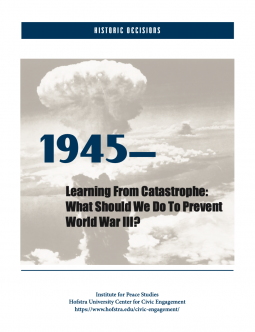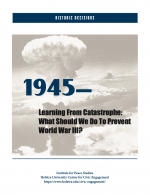Scroll down for the Learning from Catastrophe issue guide.
IT’S LATE SUMMER OF 1945 AND THE WAR IS OVER. The world is bringing to a close the most catastrophic and all-enveloping event in human history, a truly global war that has consumed 50-80 million people (about three percent of the world’s population), most of them civilians. Moreover, the war concluded with the bombing of Hiroshima and Nagasaki, the first-time deployment of weapons capable of historically unprecedented mass destructive power. For Americans, the pressing question of the moment is: How do we prevent a recurrence of catastrophe on this scale? How can we best avoid World War III?
What should we do? How can we keep Americans safe, and guarantee that a third world war—likely far worse, as hard as that is to imagine, than this last one—will not expose the country to more death and destruction? Technological changes, disruption of the traditional global balance of power, new capabilities and opportunities—all of these make the decision much harder and more complicated than it has been previously, when isolationism seemed to work, and indeed to be the only sensible choice. We now have an opportunity, but also a responsibility, unique in history: to choose between some very different options as to how best to keep ourselves safe.
Option 1: Unite Globally to Prevent War
Option 2: Maintain Military Dominance to Preserve Our Way of Life
Option 3: Create a Just World to Preserve Peace


